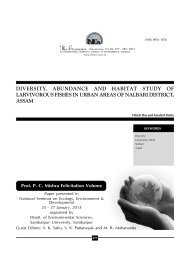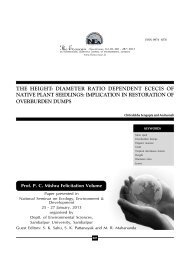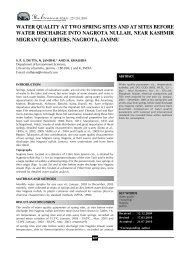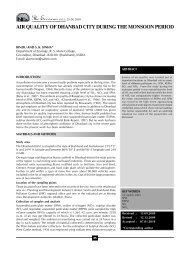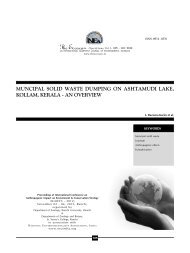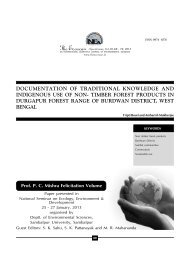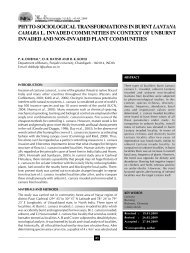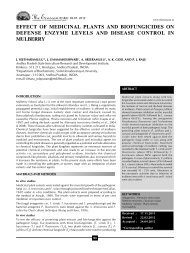Soma Chanda.pmd - An International Quarterly Journal of ...
Soma Chanda.pmd - An International Quarterly Journal of ...
Soma Chanda.pmd - An International Quarterly Journal of ...
You also want an ePaper? Increase the reach of your titles
YUMPU automatically turns print PDFs into web optimized ePapers that Google loves.
NSave Nature to Survive<br />
QUARTERLY<br />
SOMA CHANDA* AND AMBARISH MUKHERJEE<br />
Centre for Advanced Study, Department <strong>of</strong> Botany, University <strong>of</strong> Burdwan<br />
Burdwan - 713 104, West Bengal, INDIA<br />
E-mail: somac10@gmail.com<br />
ABSTRACT<br />
During the course <strong>of</strong> an ethnobotanical study<br />
undertaken in tropical dry deciduous forest in<br />
Matha <strong>of</strong> Purulia district, West Bengal, the<br />
authors recorded through an intimate contact<br />
with the different tribal communities <strong>of</strong> the<br />
area (viz. Santhal, Bhumij, Munda) their knowledge<br />
about the non-timber use <strong>of</strong> 35 species<br />
belonging to 27 families <strong>of</strong> which 28 are dicotyledonous,<br />
six monocotyledonous and one<br />
pteridophytic. A precise account has been prepared<br />
in this work <strong>of</strong> their habits, ethnic names,<br />
present status in the study site and use, an<br />
analysis <strong>of</strong> which shows11 different use categories.<br />
The knowledge <strong>of</strong> the tribes which<br />
traditionally concerns medicinal use <strong>of</strong> 20<br />
species is noteworthy. It is interesting to find<br />
three species linked with their religious and<br />
cultural activities. Sustainable use <strong>of</strong> these<br />
plants for conservation and economic benevolence<br />
<strong>of</strong> the indigenous communities are necessary.<br />
INTRODUCTION<br />
India is a country which is flourished with pr<strong>of</strong>ound forest resources. However the<br />
annual loss <strong>of</strong> Indian forests is presently about 1.5 million hectares (Ahmed, 2004)<br />
so that the existing forests cover is about 20% <strong>of</strong> the total geographical area <strong>of</strong> the<br />
country. Since this value needs to be elevated nearly to one third <strong>of</strong> the total<br />
geographical area, efforts are launched on war-footing for aforestation collaterally<br />
with restoration and conservation <strong>of</strong> the existing forests utilizing the self designing<br />
capacity <strong>of</strong> the nature. The non-timber forest products (NTFP), i.e. “<strong>An</strong>y commodity<br />
obtained from the forest that does not necessitate harvesting trees” (<strong>An</strong>on., 2008)<br />
have now started getting consideration in matters <strong>of</strong> conservation through their<br />
sustainable economic use. In view <strong>of</strong> the foregoing, the present work was<br />
undertaken in such an area as Matha a forest <strong>of</strong> Ayodhya hill which is rich in both<br />
density and diversity <strong>of</strong> tribal populations. The present work, new <strong>of</strong> its kind for the<br />
area, adheres to the objective <strong>of</strong> documenting from primary sources the indigenous<br />
knowledge about the use <strong>of</strong> forest plants associated with the lives <strong>of</strong> the hill tribes.<br />
This work is in conformity with the earlier work <strong>of</strong> the present author on the Sikari<br />
tribe settled in Ayodhya Hills (<strong>Chanda</strong>, 2010).<br />
Study Site<br />
Purulia, lying between 22º60’ and 23º50’ north latitude and 85º75’ and 86º65’<br />
east longitude, is one <strong>of</strong> the draught prone and economically backward districts <strong>of</strong><br />
West Bengal. The district occupies an area <strong>of</strong> 6259 sq km with forests covering<br />
nearly 87.60 thousand hectares and ranks second in West Bengal so far tribal<br />
diversity and density are concerned. The present work was undertaken in Matha<br />
forest <strong>of</strong> Ayodhya hill, which is a tribal dominated area. The climate <strong>of</strong> the area is <strong>of</strong><br />
tropical monsoon type with three seasons, viz. pre-monsoon (mid-February to<br />
mid-June), monsoon (mid-June to mid-October) and post-monsoon (mid-October<br />
to mid-February).The soil is <strong>of</strong> lateritic type and the temperature ranges from 26ºC<br />
to 44ºC during summer and from 11ºC to 24ºC during winter. <strong>An</strong>nual rainfall is<br />
more or less 1033mm and .relative humidity is highest during July to September.<br />
MATERIALS AND METHODS<br />
*Corresponding author<br />
Field work was performed during 2010 and 2011 in Matha forest range to document<br />
the primary data concerning the plants species used as sources <strong>of</strong> food, fuel,<br />
forage, medicine and drugs, dyes, fibers and other essentials as classified under<br />
non timber forest produce (NTFP) by Neggi (2002). The primary data were based<br />
on the knowledge and experience gained from knowledgeable informants, middleaged<br />
women and medicine men <strong>of</strong> different tribal community following standard<br />
ethnobotanical methods (Rao, 1989). Pertinent plant specimens were collected<br />
adequately some <strong>of</strong> which were taxonomically worked out to identify them using<br />
relevant literature (Prain 1903; Guha-Bakshi 1984; Bennet 1987; Panigrahi and<br />
Murti, 1989; Murti and Panigrahi, 1999) and the rest were processed for herbarium<br />
preservation as voucher specimens following Jain and Rao (1977).<br />
66





